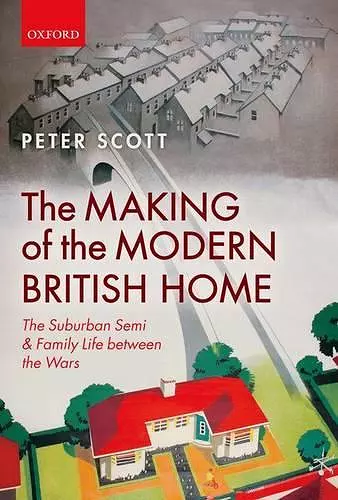The Making of the Modern British Home
The Suburban Semi and Family Life between the Wars
Format:Hardback
Publisher:Oxford University Press
Published:29th Aug '13
Currently unavailable, and unfortunately no date known when it will be back

The Making of the Modern British Home explores the impact of the modern suburban semi-detached house on British family life during the 1920s and 1930s - focusing primarily on working-class households who moved from cramped inner-urban accommodation to new suburban council or owner-occupied housing estates. Migration to suburbia is shown to have initiated a dramatic transformation in lifestyles - from a `traditional' working-class mode of living, based around long-established tightly-knit urban communities, to a recognisably `modern' mode, centred around the home, the nuclear family, and building a better future for the next generation. This process had far-reaching impacts on family life, entailing a change in household priorities to meet the higher costs of suburban living, which in turn impacted on many aspects of household behaviour, including family size. This volume also constitutes a general history of the development of both owner-occupied and municipal suburban housing estates in interwar Britain, including the evolution of housing policy; the housing development process; housing and estate design, lay-outs, and architectural features; marketing owner-occupation and consumer durables to a mass market; furnishing the new suburban home; making ends meet; suburban gardens; social filtering and conflict on the new estates; and problems of 'mis-selling' and 'Jerry building'. Peter Scott integrates the social history of the interwar suburbs with their economic, business, marketing, and architectural/planning histories, demonstrating how these elements interacted to produce a new model of working-class lifestyles and 'respectability' which marked a fundamental break with pre-1914 working-class urban communities.
Scott's well-grounded and comprehensive account will be the definitive book on this subject for years to come. * Grace Lees-Maffei, The Times Higher Education Supplement *
Highly recommended. * CHOICE *
Scott offers us a systematic and balanced survey of the interwar suburb ... Nicely illustrated, well written, and clearly organized, this book may profitably be read by anyone with an interest in the modern history of British cities and housing as well as by historians of class and gender. * Richard Harris, Journal of British Studies *
Scott provides a comprehensive narrative and analysis covering both [municipal and private] enterprise ... He covers the development process, construction, marketing, and finance. Other chapters describe the transition from the social intimacy of inner-city working-class life, and the adaptation to more middle-class conventions of respectability and aloofness. Innovative chapters are devoted to what that new life was like. A particularly fascinating one covers the devotion to gardening, a distinctive feature of British urban living ... Housing is shaping up to become major social crisis. But there is little understanding of a more successful past, and no inclination to return to it. Scott's excellent book describes this interwar success with solid authority. * Avner Offer, Journal of Social History *
Throughout the book the author extracts interesting details from the questionnaires and the life histories, and discusses in an even-handed manner the pros and cons of, for example, suburban homeownership or the financing system. * Volker M. Welter, American Historical Review *
- Winner of Shortlisted for the Wadsworth Prize 2014.
ISBN: 9780199677207
Dimensions: 240mm x 163mm x 25mm
Weight: 612g
290 pages